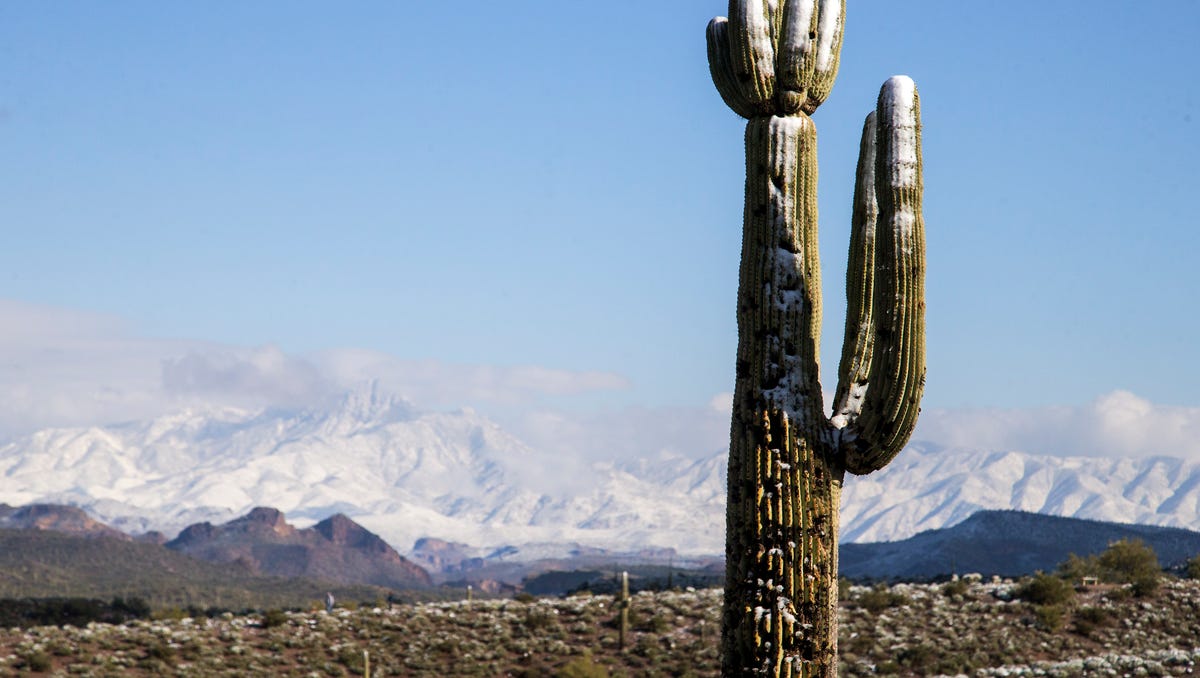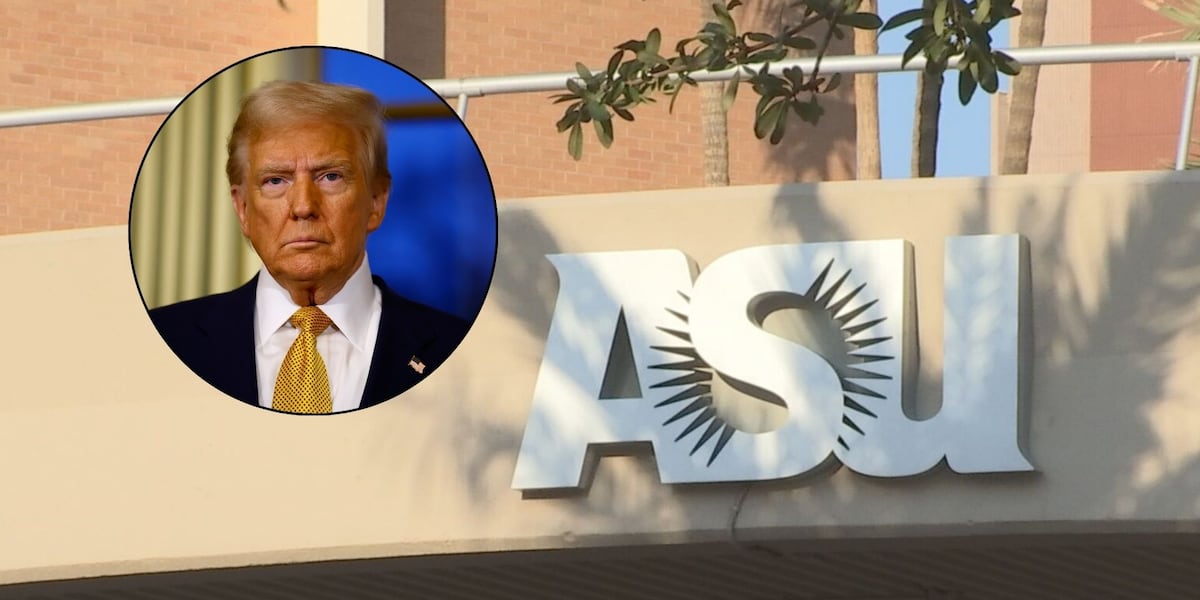Arizona
University of Arizona advances human spaceflight research with NASA
/cloudfront-us-east-1.images.arcpublishing.com/gray/OZTKSA62OVDEFNLE2INQ7XZ6DI.jpg)
TUCSON, Ariz. (13 News) -The University of Arizona’s relationship with NASA just got even stronger.
A new Space Act Agreement between the U of A and the Johnson Space Center will allow students and staff to be closely involved in human spaceflight missions.
The Johnson Space Center in Houston, Texas, is the hub for human space travel and now the University of Arizona will have even more access to their research and technology.
“We’ve run many missions for NASA from the University. We’ve contributed sensors and other technologies for many more, but we’ve not expanded into human spaceflight really as far as we think we can,” said University Vice President of Research John O’Neil.
Activities under the agreement will be pursued through university programs in various disciplines, including aerospace engineering, aeronautics, Earth and space science, radiation science and technology, human health and performance in space, and space materials.
O’Neil said student scientists will be working hand in hand with scientists at NASA Johnson, sharing ideas and research and helping support people in space.
“NASA Johnson is very good about connecting students with people who are actually on the space station for instance, to communicate and give perspectives and things like that,” O’Neil said. “But really it’s more about how do we add value to the missions and all of the technical problems and issues and concerns that you have that feed into putting people in space, whether it’s going to the moon or mars.”
And there’s no better place for students to support innovations in space exploration than the University’s new Applied Research Building. The building is equipped with a lab to evaluate the performance of objects ranging from airplane wings to sensors. It also has an anechoic chamber room where they can test antennas and look for stray radio frequency emissions.
“This is designed so that no sound interferes with the testing,” O’Neil said, standing outside the anechoic chamber room.
The building also has a 30-foot-long thermal vacuum chamber that simulates environmental conditions in space.
“We certainly hope to support some of the Artemis work coming down the line and they’ve already designed new space suits for the Artemis mission,” O’Neil said. “The thermo-vat chamber that we have can simulate the conditions in space and so testing out systems like space suits can be done right here on site. We have the largest facility for that type of work to be done anywhere in a university in America.”
Students will be able to participate in unique mentorships and internships with NASA Johnson and have opportunities to conceive research projects as undergraduates.
“But more importantly it will inform their life choices whether its to be an astronaut, whether it’s to become a bench scientist, or whether it’s to become a leader of some other form,” O’Neil said.
O’Neil said human space flight is being prioritized in the federal budget and national security priorities. He’s proud the U of A can play an even bigger role in helping the country reach for the stars.
“Human spaceflight is a huge priority for the U.S. government right now and it’s in its resurgence. We contributed to the planning for the Apollo missions and things like that back in the 60s. Now it’s our chance to give back once again,” O’Neil said.
Be sure to subscribe to the 13 News YouTube channel: www.youtube.com/@13newskold
Copyright 2023 13 News. All rights reserved.

Arizona
Winter is coming, Arizona. Here’s what NOAA, AccuWeather, almanac are predicting

What’s the winter forecast? Watch AccuWeather’s winter outlook.
It won’t be long until the cold and snow return. AccuWeather’s long-range experts share what you can expect this winter to be like in the U.S.
Winter starts Dec. 21, and as those colder months creep closer, Arizonans want to know what they should anticipate.
Before you start breaking out your sweaters and making your northern Arizona ski trip plans, you need to know what this winter has in store.
The Old Farmer’s Almanac, AccuWeather and the National Oceanic and Atmospheric Administration have released their predictions for what the following winter months should bring, including snowfall, rain and temperatures.
To best understand what Arizona weather should bring for this winter season, 2025 to 2026, here’s everything to know about the Old Farmer’s Almanac, AccuWeather and the NOAA predictions.
When is the first day of winter 2025?
Winter starts on Sunday, Dec. 21, 2025.
NOAA predicts winter will be dry and warm
NOAA predicts that most of Arizona will be 60-70% above normal temperatures for the months of November, and December. Although the southwest corner of Arizona shows it will be 40-50% above normal temperatures.
For the months of January, February and March, central and southern Arizona shows the temperature would be 40-50% above normal, while northern parts of Arizona would be 33-40% above normal temperatures.
For the months of November and December, precipitation for the western half of the state was expected to be 33-40% lower than usual according to NOAA. While the eastern part of Arizona similarly shows a 40-50% lower than normal precipitation prediction.
January, February, and March precipitation predictions remain similar, with the central and southern parts of Arizona having 40-50% lower-than-normal precipitation and the northern part predicted to have 33-40% lower-than-normal precipitation, according to NOAA.
This will make for a dry winter with little snow due to the lack of moisture in the air and warm temperatures.
AccuWeather predicts a warmer winter with late season rainfall
The Southwest’s temperatures should run historically higher than usual due to warmth in the Pacific Ocean. According to AccuWeather’s map, central and southern Arizona’s temperatures will run at about three degrees or more above average based on historical temperatures in this region.
The warmth from the Southwest will also create a drier-than-usual season with precipitation expected to be 50-74% lower than usual, making out-of-season wildfires possible, according to AccuWeather.
Yet, January will most likely bring rainfall for the Southwest. However, come February, Arizona will return to being warm and dry, potentially bringing near-record temperature highs for February.
Lower than average snow was also expected in northern Arizona, according to AccuWeather. However, an early burst of winter storms was expected, with a lull of snow in the mid-winter season, then a resurgence in the late months of winter.
Old Farmer’s Almanac predicts warm winter with rain, snow in mountains
Phoenix and Tucson should expect warmer winter weather. The coldest temperatures were expected mid-November to early January, according to the almanac, with rain and mountain snow hitting various areas.
High elevation areas should prepare for snow in early December and January.
Snowfall was predicted to be above average in eastern parts of the desert Southwest region such as Show Low, with the snowiest periods being early December to mid-January, according to the almanac.
Flagstaff also should expect above normal snowfall and temperatures, and slightly-above-normal precipitation. According to the almanac the snowiest periods were set for late January to late March.
Arizona
White House asks another Arizona university to agree to agenda for more funding access

PHOENIX (AZFamily/CNN) — A few weeks removed from the University of Arizona being asked to accept the White House’s agenda in order to get more funding access, another Arizona school is also getting the request.
The Trump administration sent the same letter to Arizona State University that the U of A and eight other schools also received earlier this month, according to CNN.
The letter asks the universities to sign a “Compact for Academic Excellence in Higher Education” committing them to adopt the White House’s vision for America’s campuses. It asks them to accept the government’s priorities on admissions, women’s sports, free speech, student discipline and college affordability, among other topics.
An initial list of schools that received the letter included Vanderbilt University, University of Pennsylvania, Dartmouth College, University of Southern California, Massachusetts Institute of Technology, University of Texas, University of Arizona, Brown University and University of Virginia.
Since then, ASU, the University of Kansas and Washington University in St. Louis were also asked to join the agreement.
It’s not clear how or why these schools were selected, or whether similar offers might go out to additional colleges. The letter indicates a deadline of Nov. 21 for schools to decide.
The University of Virginia, USC, Penn, Brown University, Dartmouth College and the Massachusetts Institute of Technology have all also rejected the proposal, and no school has yet accepted it.
On Friday, Tucson City Council voted 7-0 to pass a resolution calling on the U of A to reject compliance with the letter. School officials have said they are reviewing the compact, and U of A President Suresh Garimella said the “proposal has generated a wide range of reactions and perspectives.” The school has not indicated if it intends to agree to the letter or not.
Arizona’s Family has reached out to ASU for a statement on the White House’s proposal.
CNN and The Associated Press contributed to this report.
See a spelling or grammatical error in our story? Please click here to report it.
Do you have a photo or video of a breaking news story? Send it to us here with a brief description.
Copyright 2025 KTVK/KPHO. All rights reserved.
Arizona
Two bodies found in vehicle near 51st and Peoria avenues in Glendale

GLENDALE, AZ — Two bodies were discovered inside a vehicle near 51st Avenue and Peoria Avenue on Sunday morning, according to Glendale police.
The bodies were found around 10:30 a.m. after family members of a missing man used a phone tracking app to find his last known location.
When they arrived, they found the vehicle with two deceased individuals inside and called the police.
Investigators say both victims are believed to be adult males, but due to advanced decomposition, their exact ages, identities, and genders are still pending.
At this time, police say an official cause of death has not been determined. The second person is believed to be a friend or acquaintance of the man reported missing.
This is a developing story. Stay with ABC15 for updates as more information becomes available.
-

 World14 hours ago
World14 hours agoIsrael continues deadly Gaza truce breaches as US seeks to strengthen deal
-

 Alaska7 days ago
Alaska7 days agoMore than 1,400 seeking shelter as hundreds wait to be evacuated after catastrophic Western Alaska storm, officials say
-

 News14 hours ago
News14 hours agoTrump news at a glance: president can send national guard to Portland, for now
-

 Business13 hours ago
Business13 hours agoUnionized baristas want Olympics to drop Starbucks as its ‘official coffee partner’
-

 North Carolina1 week ago
North Carolina1 week agoGuide to NC State Fair 2025: Tickets, transportation, parking, new rides and special event days
-

 Politics12 hours ago
Politics12 hours agoTrump admin on pace to shatter deportation record by end of first year: ‘Just the beginning’
-
Science13 hours ago
Peanut allergies in children drop following advice to feed the allergen to babies, study finds
-

 World1 week ago
World1 week agoAlbanian judge killed in courtroom shooting amid growing anger over justice system reforms
























